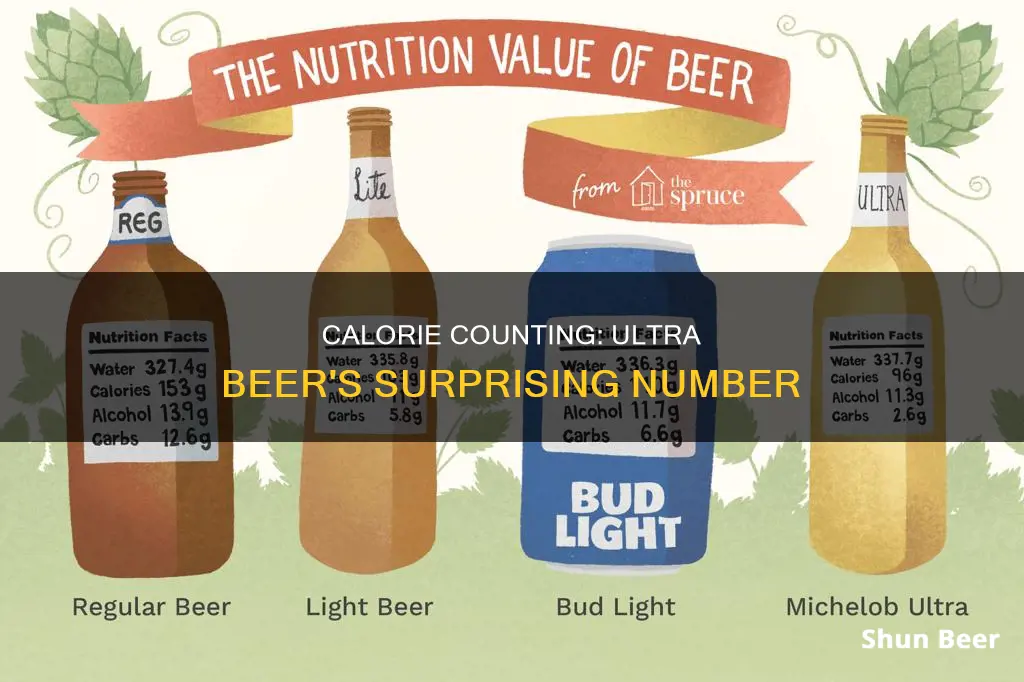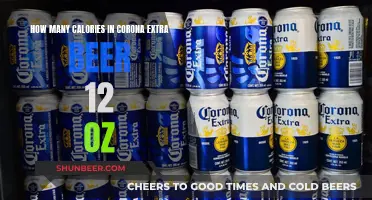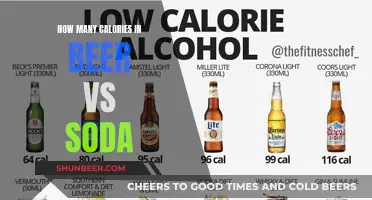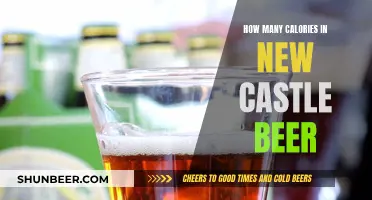
Beer is a popular drink worldwide, but it's important to remember that it contains calories, which can lead to weight gain if consumed in excess. The number of calories in beer varies depending on the brand, type, and serving size. Michelob Ultra Beer, for example, is a popular light beer with a relatively low-calorie content. A 12-ounce bottle or can of Michelob Ultra Beer contains 95 calories, which is towards the lower end of the calorie range for beers. This calorie count is comparable to other light beers such as Bud Light and Busch Light. The calories in beer primarily come from carbohydrates and alcohol, and the higher the ABV, the more calories the beer will have.
What You'll Learn

Michelob Ultra Light Beer has 95 calories per 12 fl oz can or bottle
Michelob Ultra Light Beer is a popular choice for health-conscious drinkers, fitness enthusiasts, and athletes. With only 95 calories per 12 fl oz can or bottle, it is a great option for those watching their calorie intake. This is significantly lower than some of its competitors, such as Bud Light, which has 110 calories, and Coors Light, which has 102 calories.
Michelob Ultra Light Beer's calorie count is even more impressive when compared to the average calorie count of popular beers in the United States. The calorie count for a standard 12-ounce serving of one of the top 10 most popular beers in the country ranges from around 95 calories on the low end to just under 150 calories on the high end. At 95 calories, Michelob Ultra Light Beer is at the lower end of this range, making it a relatively light option.
The beer's low-calorie count can be attributed to its strategic marketing, targeting health-conscious consumers who crave a beer that is lower in calories and carbs. This positioning has been a key factor in its success, with Michelob Ultra becoming one of America's top light beers and the third-largest beer brand in the United States in 2019.
In addition to its low-calorie content, Michelob Ultra Light Beer also has a low-carb count, with only 2.6 grams of carbohydrates per serving. This is lower than competitors like Natural Light and Busch Light, which have 3.2 grams of carbohydrates each. The low-carb count has made Michelob Ultra a popular choice among those following a keto diet, as it fits within the diet's strict requirements of consuming fewer than 50 net carbs per day.
Michelob Ultra Light Beer's nutritional profile, with its low calorie and carb counts, makes it a popular choice for those seeking a healthier option without compromising on taste. Its success and popularity demonstrate that light beer continues to be in high demand, even in the face of the rising popularity of craft beers and spritzer-style canned cocktails.
Stout Beer Calories: How Many in a Regular Serving?
You may want to see also

Calories in beer are mainly from carbs and alcohol
Beer is made by fermenting grains such as barley and wheat, which naturally contain carbohydrates. Additionally, most beers contain added sugars, further increasing the carbohydrate content. The amount of carbohydrates in beer can vary depending on the ingredients and overall sugar levels.
The number of grains and added sugars that remain in the beer after the fermentation process also plays a role in the carbohydrate content. For example, a 12-ounce serving of Budweiser contains 10.6 grams of carbohydrates, while Bud Light, a lighter version, contains 6.6 grams.
In addition to carbohydrates, alcohol also contributes to the calorie content of beer. The alcohol content of beer is typically listed by volume, and a higher alcohol percentage usually equates to a higher calorie count. For instance, Budweiser has an ABV of 5%, while Bud Light has an ABV of 4.2%, and Budweiser has more calories.
When it comes to calorie content, a standard 12-ounce serving of beer in the United States can range from around 95 calories on the lower end to just under 150 calories on the higher end. Lighter beers tend to be lower in calories, while darker, more complex varieties tend to be heavier and higher in calories.
So, if you're watching your calorie or carbohydrate intake, it's important to consider the type of beer you're consuming. While beer may not be suitable for diets that severely restrict carbohydrates, some light beers with lower carb content may fit into less restrictive diets.
Calorie Counting: Beer-Battered Onion Rings
You may want to see also

Beer has more calories than wine or spirits
A standard 12-ounce serving of one of the top 10 most popular beers in the United States ranges from around 95 calories to just under 150 calories. Michelob Ultra, a popular low-calorie beer, contains 95 calories per 12-ounce can or bottle. In contrast, a 175ml glass of 12% ABV wine contains around 133 calories. This is equivalent to eating three Jaffa Cake biscuits.
On average, a pint of beer has 50% more energy content than a small glass of wine, which can lead to weight gain if consumed in excess. The calorie difference between beer and wine can be attributed to the leftover carbohydrates found in beer, while wine typically has a lower sugar content. Beer is made from grains and yeast, and the calorie content can vary depending on the type, with lighter beers generally containing fewer calories than darker beers. For example, most light beers have between 60 and 120 calories, while dark beers can have between 100 and 300 calories due to their higher carbohydrate content.
While beer may have more calories, it also has some nutritional benefits. Beer often contains protein, fiber, B vitamins, folate, and niacin, which can provide health benefits when consumed in moderation. Additionally, beer contains polyphenols, which offer modest health benefits similar to those found in white wine, although red wine contains higher levels of these beneficial compounds.
If you're looking to cut down on calories but still want to enjoy an alcoholic beverage, spirits like vodka, gin, or tequila, or a glass of champagne, are good options as they tend to be lower in calories.
Stone IPA Beer: Calorie Count and Nutrition Facts
You may want to see also

Alcohol-free beers have fewer calories
A standard 12-ounce serving of beer in the United States ranges from 95 calories on the low end to just under 150 calories on the high end. Michelob Ultra, a popular "ultra-light" beer, contains 95 calories per 12-ounce serving, which is less than competitors like Bud Light (110 calories) and Coors Light (102 calories). Even the organic version of Michelob Ultra contains fewer calories, at 85 per 12-ounce serving.
Alcohol-free beers, by definition, will always have fewer calories than their alcoholic counterparts. This is because alcohol itself contains calories: seven calories per gram, to be precise. And, while the exact number of calories in a beer will vary depending on its ingredients and how it's made, alcohol generally contributes a significant portion of the total calories. So, by removing the alcohol, you're also removing a substantial number of calories.
Additionally, many alcohol-free beers are marketed as "light" or "low-calorie" options, specifically targeting health-conscious consumers. For example, Michelob Ultra, which was introduced in 2002 as a light beer for health-conscious drinkers, fitness enthusiasts, and athletes, has just 95 calories per 12-ounce serving. This is due in part to its relatively low alcohol content of 4.2% ABV.
It's worth noting that, while alcohol-free beers will have fewer calories, they may not always taste exactly the same as their alcoholic equivalents. The process of removing alcohol can sometimes affect the flavor profile of the beer. However, with the growing popularity of alcohol-free options, brewers are becoming increasingly skilled at creating tasty, low-calorie alternatives that closely resemble the real thing.
In conclusion, if you're looking to cut down on calories without sacrificing the occasional beer, alcohol-free options are definitely the way to go. Not only do they have fewer calories, but many of them are also designed with health-conscious consumers in mind, so you can be sure you're making a better choice for your waistline.
Calorie Counting: Stella Artois Beer Edition
You may want to see also

Calories in beer = ABV% x 2.5 x ounces of beer
A 12-ounce serving of beer typically contains between 95 and 150 calories. The calorie content of beer depends on several factors, including the alcohol content, the amount and type of carbohydrates, and the brewing process.
The formula for calculating the number of calories in a beer is: Calories = ABV% x 2.5 x ounces of beer. This formula provides a simple way to estimate the calorie content of a beer based on its alcohol by volume (ABV) percentage and the volume of the beer in ounces.
For example, let's consider a 12-ounce serving of Michelob Ultra Beer, which has an ABV of 4.2%. Using the formula, we can calculate the calories as follows:
Calories = 4.2% x 2.5 x 12 ounces = 95.4 calories
Rounding this value to the nearest whole number, we find that a 12-ounce serving of Michelob Ultra Beer contains approximately 95 calories. This value is consistent with the information provided by other sources, which state that Michelob Ultra Beer contains 95 calories per 12-ounce serving.
It is worth noting that the formula provides an estimate and may not be as accurate as more complex calculations that take into account additional factors such as the original and final gravity of the beer. However, it offers a practical way to quickly estimate the calorie content of a beer, especially when detailed information about the beer is not readily available.
By using this formula, you can make more informed choices about your beer consumption and how it fits within your dietary goals.
Spotted Cow Beer: Calorie Count and Nutrition Facts
You may want to see also
Frequently asked questions
A 12 fl. oz can or bottle of Michelob Ultra Superior Light Beer contains 95 calories.
The calorie count for a standard 12-ounce serving of one of the top 10 most popular beers in the United States ranges from around 95 calories on the low end to just under 150 calories on the high end. Therefore, Michelob Ultra Superior Light Beer is on the lower end of the calorie count for beers.
The calories in beer are mainly made up of carbs and alcohol. Craft, seasonal beers, and beers with high alcohol content will tend to have more calories than lighter ones.







